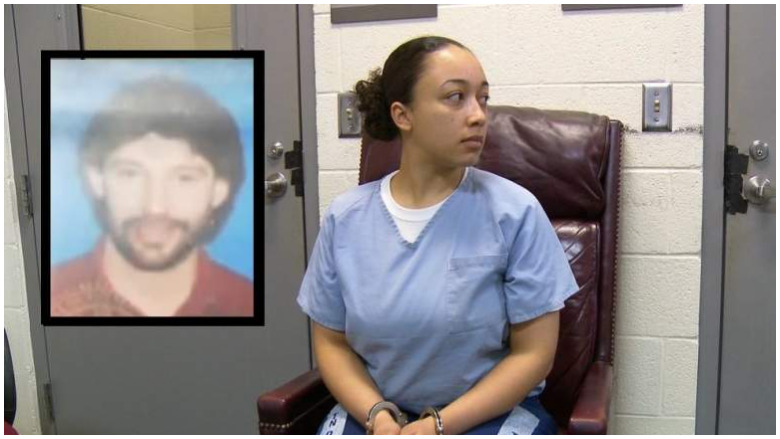
YouTube Johnny Michael Allen
It was August 2004, and Johnny Michael Allen, a youth minister and real estate agent, sat in his pickup truck in a Nashville parking lot awaiting 16-year-old Cyntoia Brown. Allen, 43, had solicited the minor for sex, and drove to his home with her in the car.
The two engaged in conversation at the home before eventually heading to his bedroom. As he lay naked on his bed, he was fatally shot in the head by Brown, who had endured many years of abuse and was a teenage sex worker. Following her arrest, she told detectives she feared for her life during the encounter and claimed self-defense in the murder. After a trial, she was found guilty and received a life sentence on murder and prostitution charges. She previously wasn’t eligible for parole until she’s 69.
On January 7, 2019, Tennessee Governor Bill Haslam ordered an early release for Brown.
According to the Tennessean, Haslam “granted Brown a full commutation to parole…Brown will be eligible for release Aug. 7 on time served and will stay on parole for 10 years.”
It’s a story that was told by Daniel Birman in the 2011 documentary “Me Facing Life.” Birman’s film followed Brown’s life in prison and helped initiate tougher prostitution laws in Tennessee. Now, only those who are 18 and older can be charged for prostitution. Brown’s journey resurfaced on social media, with various celebrities sharing posts calling for a new trial.
During her trial, the prosecution painted Cyntoia Brown as, in the words of The Tennessean in 2004, “a manipulative, calculating teen who has used up all her chances in the juvenile justice system and is a danger to the public.”
Defense attorneys claimed that she was mentally ill, had a troubled history, and had been living on the streets. The victim was shot in the head. The autopsy, the newspaper reported, showed that “death would have been instantaneous from the gunshot that entered the back of the head and exited his forehead between his eyes.”
The celebrity posts led the term #FreeCyntoiaBrown to become a global trend across various social media platforms.
So, who is Johnny Allen? Here’s what you need to know about him, Brown and the incident:
1. Allen & Brown Met in a Sonic Parking Lot Prior to His Murder

Johnny Allen
As a teenager, Brown had a troubled past. She stated that she was abused as a child and her parents weren’t there for much of her life. She lived in Middle Tennessee and had been involved in several incidents which led to her being a frequent visitor of the Tennessee juvenile justice system, Brantley Hargrove of the Nashville Scene wrote. She was prescribed medications for anxiety and depression and had several outbursts while under supervision.
When she was 16, she was living out of a room at a South Nashville motel and was seeing a 24-year-old drug dealer and criminal at the time known to many as “Cut Throat.”
During her trial, Brown cited numerous incidents where her boyfriend assaulted her, sometimes to the point of unconsciousness. She said that they were either doing drugs or having sex much of the time while they lived at the motel. In order to make extra money to support their living, Cut Throat would often send Brown out onto the streets of Nashville, offering sexual favors for money.
“She didn’t like thinking of herself as a prostitute, but that’s what she was becoming,” Hargrove wrote.

The motel where Brown and Cut Throat stayed together in 2004.
At around 11 p.m. on August 5, 2004, Brown was looking for a ride to East Nashville for work. She didn’t have a ride, so was looking for someone at a Sonic to give her a lift.
An employee at the restaurant testified that she noticed a Ford truck driving past without its headlights. She waved it down in an effort to let him know. It was Johnny Allen behind the wheel. He apologized, fixed the headlights and drove off, she said during the trial.
You can read court documents from the case below:
Court documents indicate that Allen was once married, but got divorced in 1999. He was a former real estate agent and was known in the community. He was a youth minister at Lakewood Church of Christ and also taught Sunday school on occasion.
Brown said that Allen approached him at the Sonic and asked her if she was “up for any action,” and the two negotiated a price for sexual favors.
Allen was seen by the same employee, and Brown was in the passenger seat this time. The employee stated that with Brown in truck, Allen ordered food and pulled away. He was taking her to his home, which Hargrove described as looking “like the home of an aging spinster expecting guests for tea.”
Cyntoia Brown ended his life that night.
According to a 2006 article in the Tennessean, Allen’s relatives asked the judge, J. Randall Wyatt to punish Brown as severely as possible. “I pray that Cyntoia will never be free into society again,” Randy Allen, the victim’s brother, said in the story. During the trial, the newspaper reported, prosecutors argued that Brown “killed Allen as a ‘thrill’ and to steal from him.”
The story quotes Allen’s mother as saying, “I do not know Cyntoia Brown, and I do not hate Cyntoia. I just hate the act that she did.”
The judge said his main concern was for the victim’s family.
According to the newspaper, the judge also heard from prosecution witnesses who testified that “Brown has had dozens of rule violations while in custody; has attached teachers, nurses, and jail staff.” Prosecutors called her a “dangerous person” and a “professional criminal.” That was years before the governor’s action in 2019, though.
Various celebrities chimed in on the case in 2018 demanding Brown’s release.
https://twitter.com/KimKardashian/status/933001503123554304/photo/1
The governor ultimately agreed, saying in a statement that the sentence was “too harsh.”
“Cyntoia Brown committed, by her own admission, a horrific crime at the age of 16,” Haslam said in the statement. “Yet, imposing a life sentence on a juvenile that would require her to serve at least 51 years before even being eligible for parole consideration is too harsh, especially in light of the extraordinary steps Ms. Brown has taken to rebuild her life. Transformation should be accompanied by hope. So, I am commuting Ms. Brown’s sentence, subject to certain conditions.”
2. Brown Said She Feared for Her Life & Shot Allen in the Back of the Head

The home that Johnny Allen lived in back in 2004.
Brown said during her testimony at a hearing that she and Allen ate dinner and talked upon arriving at his home. She said that Allen told her that he was an “expert marksman” and was trained in the Army. At that point, she said that he showed her three of his guns: a double-barrel shotgun, a pistol and a .22-caliber rifle. They then walked downstairs together and watched TV for a while. She claims that Allen attempted to kiss her, but she pulled away from him. Eventually, Brown told Allen that she was feeling tired and wanted to go to sleep.
Allen allegedly brought Brown up to his bedroom, where he got naked and tried to touch her. Brown said that she denied his advances and he eventually rolled over onto his side. She claims that he would stand up and go into the bathroom for minutes at a time during the night, and said she thought he was going to grab his gun and shoot her.
At one point through the evening, with Brown on his side on the bed, she pulled out the .40-caliber pistol that Cut Throat had provided her to protect herself. Brown admitted to taking the gun to the back of Allen’s head and firing, killing him while he laid naked in his bed.
Another 2006 article in the Tennessean on the jury verdict said that a taped telephone conversation was played in court in which Brown told her mother she “executed” him. The article notes that prosecutors focused on “Brown’s theft of Allen’s truck, guns and money” and added that an acquaintance of Brown “testified that Brown wanted him to go back to Allen’s home after the killing to help her steal more.”
The article also states that another inmate claimed Brown told her “she killed Allen just to watch him die.”
The prosecutor said to The Tennessean at the time: “I’m afraid this is a dangerous person. And the city, I’m afraid, is safer without her on the streets. We try not to cheerlead about a juvenile that’s getting a sentence like this. But the bottom line is, the community is safer without her on the streets.”
3. Brown Called 911 Anonymously to Report Allen’s Death

The Walmart where Brown dropped off Allen’s truck.
After shooting Allen at point-blank range, Brown fled the home. On her way out, she stole Allen’s rifle and shotgun from his gun case, she admitted to police. She took the keys and got into Allen’s truck, speeding away and down the street toward the motel she stayed at.
It was now 2 a.m., and she said that she returned to her motel room, where Cut Throat was. According to testimony, Cut Throat “was furious” that she came back with weapons without hiding them. She later drove Allen’s truck to a Walmart in Antioch and left it there.
The next day, Brown met up with a friend, and he said in court that she told him that she shot Allen, and was willing to split over $55,000 she stole off of him. There was no money, though. She ended up getting a ride from the friend and watched the news to see if police found Allen’s body. But there was no mention of Allen’s death. She called Allen’s home, but nobody answered. She said that she hated the thought of Allen laying in the bedroom undiscovered by himself, so she decided to call 911. When the operator answered, Brown repeated Allen’s address, saying, “homicide” before hanging up.
Officers arrived at Allen’s home the night after the murder, finding him laying on the edge of the bed, covered by some of the bedspread. Investigators stated that his back was turned to where Brown would have been sleeping, and his fingers were intertwined in a relaxed position. The next morning, detectives said a man — the friend Brown spoke to the day prior — told them where to find Brown, and they arrived at the motel. At least six officers with their guns drawn knocked on the door, which was answered by Cut Throat. They stormed in and forced him down to the ground, noticing Brown nearby in a bra and panties. She started sobbing and told the responding officers that Cut Throat had nothing to do with it, adding that she would confess to what happened.
During interrogations Brown didn’t fully understand the questions and said she was promised that a “deal” would be made. She admitted to shooting Allen because of self-defense. She further confessed and was booked into the jail. She was eventually transported to a mental health institute and “became a nightmare patient,” Hargrove wrote, with threats and attacks against nurses becoming frequent. Counselors suspected that Brown had borderline personality disorder, but noted in court documents that an official diagnosis wasn’t allowed until she turned 18. She ended up being charged as an adult, and the doctor who evaluated her never took the stand during her trial.
After nearly half a year at the institute, Brown found out that Cut Throat had been shot to death in a dispute.
4. A Witness, While Testifying, Accused Allen of Raping Her & Allen Dreamed of Becoming a Country Songwriter
After Brown confessed to the murder, the news quickly spread around the area. Some media outlets reported the story as having the narrative of a criminal black woman killing a wealthy white professional. Word spread around the community, and a headline in The Tennessean referred to Allen as trying to be a “good Samaritan.”
One of Allen’s former co-workers at the real estate agency was quoted in the story, saying that Allen and Brown probably connected because he was about to send her down the right path in life.
“God probably put him in her path to make a choice,” the former colleague of Allen’s said to the newspaper. “(Allen) was the one person who was going to help her turn her life around. That’s sad.”
2004 article in the Tennessean said that Brown met Allen in a fast-food restaurant. At the time, a police spokesman claimed to the newspaper “He understood her to be homeless and, according to her, he took her home.” The article claimed that Allen “may have been a good Samaritan.” Allen’s friends suspected he was “helping the girl, as he was known to do for the homeless, sometimes through his church,” the article claimed.
He had been a realtor since 1995 and was described in that story as respected, a “top producer” and a person who “always did business that superseded what was moral.” He wanted to be a country songwriter but “didn’t like the cutthroat music business.”
But Brown’s attorneys during the trial aimed to tarnish the reputation that Allen had established within the community. They brought forth two witnesses for questioning. One of them was a 17-year-old Jessica Snyder, who worked at a restaurant in the area. Allen was a regular there, and Snyder said during her court testimony that many waitresses would often fight over who had to serve him because he made them so uncomfortable. Snyder said that one time, he handed her his business card and wrote a personal message on the back.
“You’re gorgeous,” Snyder said the card read. “I’d love to take you out sometime, so let me know.”
However, the judge labeled her testimony irrelevant, and he didn’t allow the jury to hear it. The second witness was another woman who had contact with Allen. She said that the two met at a Mexican restaurant after he winked at her from the table he was sitting at. They ended up having a conversation, she said in court, and Allen recommended a new church for her to attend, the same one he was affiliated with.
The woman told the jury that she attended a few of his classes at the church, and agreed to go out with him. She claimed that instead of going to a movie, like had been planned, he picked her up from her place and invited her into his home. Once inside, she claimed that Allen started kissing her inside his bedroom. The woman claimed that she resisted Allen’s advances and said she feared for her safety.
“After he gave me the look, and I can’t explain that look because — today I can still see it,” she said in court, according to Hargrove, adding that Allen proceeded to rape her.
Brown was never called to the stand during her trial, meaning the jury never heard her tough upbringing and stories about how she was raped as a child. The statements she made hours after the murder to her friends proved to be damning to her self-defense claim. One of the other big points prosecutors laid into was the fact that Allen’s body was discovered on his side, facing the wall with his fingers interlocked.

YouTube/A photo showing Johnny Allen’s body.
They argued that there was no way Allen’s fingers fell into that position after she shot him, and suggested that he was asleep instead of reaching for a gun, as Brown had said.
The jury found her guilty of first-degree murder and aggravated robbery. She was subsequently sentenced to life in prison and was eligible for parole after serving 51 years of her sentence.
5. Petitions Have Been Started for Brown’s Release

Wikimedia CommonsCyntoia Brown
Since Brown’s conviction and the details surrounding the case have resurfaced on social media, many have advocated for her release from prison. Brown and her attorneys appealed her conviction, but it was denied after review.
Aside from celebrities sharing the story of the incident on social media, several petitions have been started, requesting her release from prison.
“This could be or could have been your daughter,” a petition on MoveOn.org says. “This Petition needs as many signatures as possible so that it can be presented for a potential presidential pardon.” As of late November, it had nearly 130,000 signatures of its 150,000 goal.
The petition asks people to follow Brown and how she’s grown as a person on her Twitter account. It also encourages people to send her mail of support at:
#410593
3881 Stewart’s Lane
Nashville, TN 37218
Another petition was started on Change.org, and it asked then-Tennessee Attorney General Robert E. Cooper, Jr. to review the case more thoroughly and call for a new trial. Petitioners wanted the AG to take into account her background of mental and emotional disorders and abuse as a child. The petition was signed by over 25,000 people.

